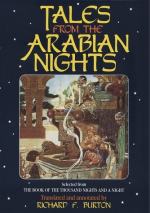Translations of
cognate oriental romances illustrative
of
the nights.
1. Les Mille et Un Jours. Contes Persanes.
“In imitation of the Arabian Nights, was composed a Persian collection entitled ‘Hazar Yek Ruz or the Thousand and One Days,’ of which Petis de la Croix published a French rendering [in 1710], which was done into English [by Dr. King, and published in 2 vols. (with the Turkish Tales=Forty Vezirs) as early as 1714; and subsequently] by Ambrose Phillips” (in 1738) (Clouston, in litt). Here, and occasionally elsewhere, I have quoted from some MSS. notes on The Nights by Mr. W. A. Clouston, which Sir R. F. Burton kindly permitted me to inspect. Mr. Clouston then quotes Cazotte’s Preface (not in my edition of the Thousand and One Days), according to which the book was written by the celebrated Dervis Mocles (Mukhlis), chief of the Sofis (Sufis?) of lspahan, founded upon certain Indian comedies. Petis de la Croix was on friendly terms with Mukhlis, who allowed him to take a copy of his work in 1675, during his residence in Ispahan. (I find these statements confirmed in the Cabinet des Fees, xxxvii. pp. 266, 274, 278, and in Weber’s “Tales of the East,” i. pp. xxxvi., xxxxii.)
The framework of the story is the same as Nos. 9a and 152: a Princess, who conceives an aversion to men from dreaming of the self-devotion of a doe, and the indifference and selfishness of a stag. Mr. Clouston refers to Nakhshabi’s Tuti Nama (No. 33 of Kaderi’s abridgment, and 39 of India Office Ms. 2,573 whence he thinks it probable that Mukhlis may have taken the tale.) But the tale itself is repeated over and over again in many Arabic, Persian, and Turkish collections; in fact, there are few of commoner occurrence.
The tales are told by the nurse in order to overcome the aversion of the Princess to men. They are as follows:
Introduction and Conclusion: Story of the Princess
of Cashmir.
1. Story of Aboulcassem Bafry.
2. Story of King Ruzvanchad and the Princess
Cheheristani.
a. Story of the
young King of Thibet and the Princess of
the
Naimans.
b. Story of the
Vazir Cavercha.
3. Story of Couloufe and the Beautiful Dilara.
4. Story of Prince Calaf and the Princess of
China.
a. Story of Prince
Fadlallah, son of Bei-Ortoc, King of
Moussel=Nos.
184 and 251.
5. Story of King Bedreddin-Lolo, and his Vazir
Atalmulk,
surnamed the Sad Vazir.
a. Story of Atalmulk
and the Princess Zelica Beghume.
b. Story of Prince
Seyf-el-Molouk.
c. Story of Malek
and the Princess Chirine.
d. Story of King
Hormuz, surnamed the King without
trouble.
da.
Story of Avicenna.
e. Story of the
fair Arouya. Cf. Nos. 135q and 225.




